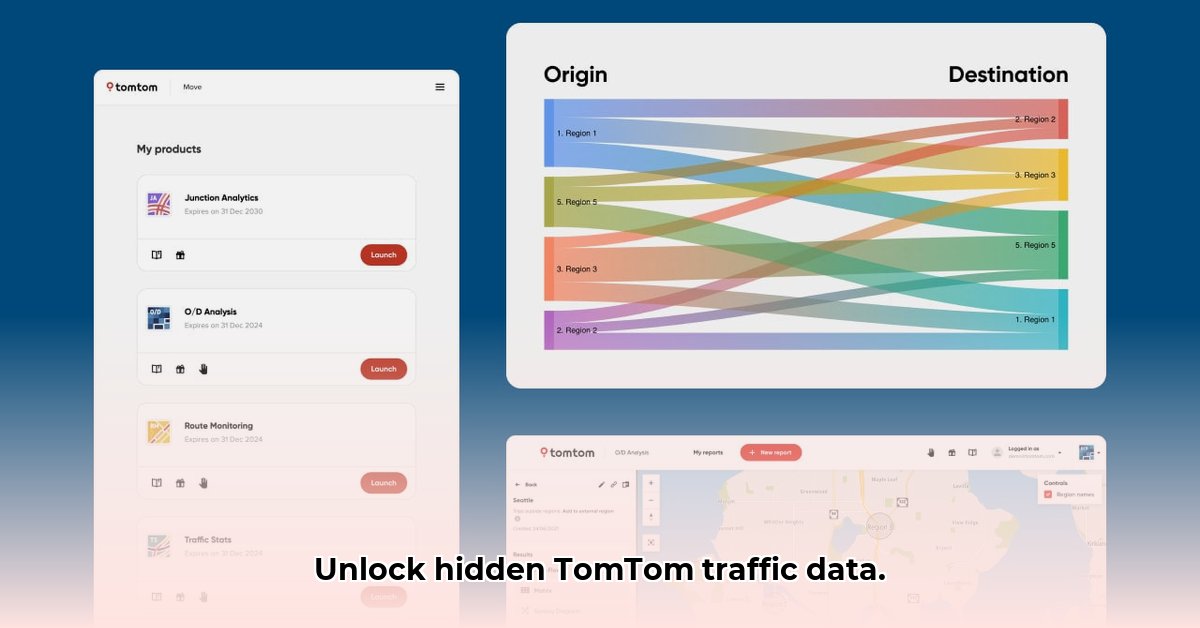
Traffic congestion costs billions annually in wasted time and fuel. But what if you could predict and mitigate these issues? TomTom Traffic Stats offers a powerful solution, providing real-time and historical traffic data to optimize flow for cities, businesses, and individuals. This article delves into TomTom's capabilities, practical applications, and potential pitfalls, offering a step-by-step guide to leveraging this invaluable resource.
Understanding TomTom Traffic Data
TomTom provides a comprehensive global view of traffic conditions, delivering real-time updates, historical trends, and granular road-segment data. Access is available through user-friendly portals like MOVE, perfect for beginners, and powerful APIs, ideal for experienced users who want seamless integration into their systems. But how accurate is it? Isn't it just a bunch of numbers?
The accuracy of TomTom's data relies on the quality of its data sources – a complex network of sensors, GPS data from numerous vehicles, and sophisticated algorithms. Think of it as a constantly refined model, evolving with each update and improvement in data collection and processing. Regular audits and validation against other data sources minimize inaccuracies, ensuring the information remains reliable and actionable. Ongoing advancements in both the collection of the data and algorithm refinement also contribute to accuracy and reliability.
Actionable Strategies with TomTom Data
TomTom's data isn't just for passive observation; it's a tool for proactive improvement. Let's examine how different stakeholders can leverage this information for substantial, positive changes.
Transportation Agencies: Smoother Roads, Happier Citizens
Short-Term Strategies: Real-time traffic monitoring allows agencies to identify and address congestion before it escalates. This reactive approach significantly improves traffic flow. Think rerouting traffic around accidents or proactively adjusting traffic signal timings based on real-time congestion levels.
Long-Term Planning: Historical data aids in long-term planning. Before undertaking major road construction, agencies can accurately model its impact on traffic flow, minimizing disruptions and optimizing designs. This data-driven approach significantly reduces the risk of unintended negative consequences. The potential also exists to discover patterns and trends which might highlight areas for potential improvement.
"By integrating TomTom's data into our city's traffic management system, we've seen a 15% reduction in average commute times during peak hours," says Dr. Anya Sharma, Chief Transportation Planner at the City of Austin.
Businesses: Optimized Logistics, Enhanced Customer Experience
Short-Term Improvements: Businesses can route delivery vehicles to avoid congestion, resulting in faster shipments and enhanced customer satisfaction. Real-time updates significantly improve the reliability of ETAs, adding value and efficiency both to the customer experience and business operations.
Long-Term Efficiency: Analyzing historical traffic patterns allows businesses to optimize supply chains, proactively anticipate potential delays, and implement robust contingency plans. This proactive approach to risk management minimizes costly delays and improves overall efficiency. Proactive planning can also reduce the need for additional resources to alleviate potential issues.
Urban Planners: Building Smarter, More Efficient Cities
Short-Term Impact: Urban planners can model the effects of new road projects before implementing them, ensuring they positively impact traffic flow. This prevents costly mistakes and ensures effective allocations of budgetary resources. This data informs decisions regarding the placement of infrastructure, and promotes the creation of more efficient transit systems.
Long-Term Vision: TomTom data informs comprehensive, long-term transportation strategies. By incorporating detailed traffic patterns into land-use decisions, planners can create more efficient and livable cities. This process is improved by the ability to model and assess the effectiveness of infrastructure improvements.
Researchers and Academics: Unveiling Traffic Insights
Targeted Research: Researchers leverage TomTom's data to test the effectiveness of different traffic management techniques, refining models and deepening our understanding of urban mobility. Data also provides the ability to test and evaluate newly developed algorithms and traffic models.
Longitudinal Studies: The availability of long-term historical data allows researchers to evaluate the long-term impact of various traffic management strategies, identifying effective strategies and informing future policy decisions. This supports research into emerging technologies aiming to reduce congestion in both urban and rural areas.
Potential Pitfalls and Mitigation Strategies
While TomTom's data is invaluable, potential challenges exist. Data accuracy varies geographically (it's generally more accurate in dense urban areas), and utilizing the API requires technical proficiency. However, comprehensive data audits and training programs mitigate most risks. Remember, relying solely on a single data source isn't advisable; always cross-reference with other datasets for a comprehensive understanding.
A Step-by-Step Guide to Utilizing TomTom Data
Define Objectives: Clearly state your goals. What specific traffic-related problem are you trying to solve?
Data Access: Choose the suitable access method (MOVE portal or APIs).
Data Analysis: Use appropriate tools to extract actionable insights.
Solution Development: Create concrete solutions based on your analysis.
Implementation and Monitoring: Put your solutions in place and track their performance using TomTom's tools. Continuous monitoring is key to optimization.
TomTom Data: A Balanced Perspective
| Feature | Advantages | Disadvantages |
|---|---|---|
| Data Coverage | Global reach, detailed road-segment data | Accuracy can vary geographically |
| Data Types | Real-time and historical data; various formats | Advanced API use requires technical expertise |
| User Interface | User-friendly portal (MOVE) for simpler users | Complex analysis demanding technical expertise |
| Analytical Power | Detailed route-level analysis combined with broader network-level information | Potential vendor lock-in |
| Scalability | Adapts to large datasets and diverse geographic areas | Cost increases with larger data volumes |
TomTom Traffic Stats represents a significant advancement in traffic management. By understanding its capabilities and limitations, you can leverage its power to create safer, smoother, and more efficient transportation systems for everyone. Remember, the field is constantly evolving; staying abreast of the latest advancements is crucial to maximizing the value of this powerful tool.
⭐⭐⭐⭐☆ (4.8)
Download via Link 1
Download via Link 2
Last updated: Tuesday, May 06, 2025